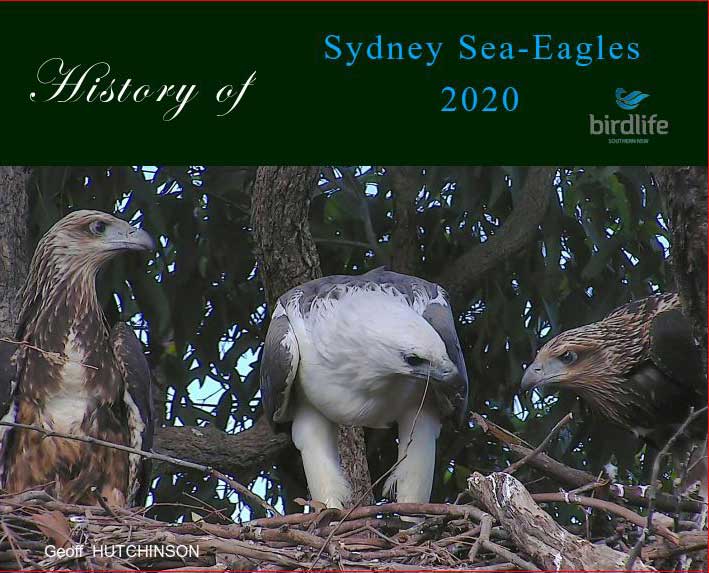Judy Harrington, Geoff Hutchinson, Jon Irvine, BirdLife Southern NSW.
In the 2017 breeding season, the resident pair of White-bellied Sea-Eagles again nested in the Nature Reserve forest, though no young survived. The study again revealed delayed incubation between the laying of the two eggs.
There has been a Sea-Eagle nest in the Newington Nature Reserve at Sydney Olympic Park by the Parramatta River for many years, with a succession of eagle pairs renovating the nest in the breeding season. There are few early records of successful breeding however and several eagles were found dead. Following the death of a pair of breeding eagles in 2004, necropsy and chemical analysis of tissues was undertaken in order to determine the cause of death. Further study was recommended. Their success or failure appears to be closely linked with environmental conditions, particularly the accumulated Persistent Organic Pesticides in Homebush Bay and the Parramatta River.
As in previous years since 2009, the breeding relationships, behaviour and diet of the White-bellied Sea-Eagles were to be studied using video CCTV cameras and by limited physical observation during daylight hours, from the time of nest renovation to fledging and beyond where possible. In early 2017 a new Research Proposal was submitted and all approvals gained.
The White-bellied Sea-Eagle Haliaeetus leucogaster (Gmelin 1788) is currently listed as a Vulnerable Species in NSW . (Biodiversity Conservation Act 2016. Gazetted date: 16 Dec 2016 Profile last updated: 01 Dec 2017).
During April and May nest renovation began in Nest 3 in an Ironbark, the nest used in 2015 and 2016. Renovations continued in May and June, with the eagles bringing sticks to build up the rails, or edges of the nest, and fresh leaves to line it. As previously observed, both eagles assisted in the construction stage.
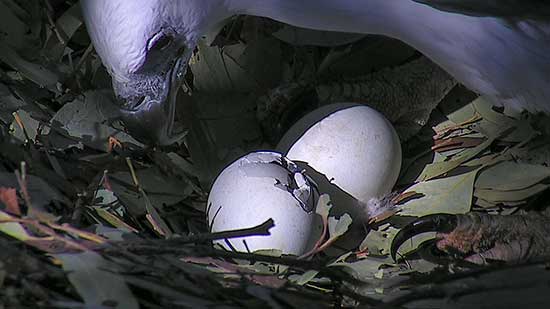

The first egg SE-19 was laid 13 June 2017, 05:40pm.
The second egg SE-20 was laid 17 June 2017, 03:00am. About 81 hours apart.
Previously, the time between laying of the 2 eggs has varied from 3 to 5 days when we were able to observe the lay. Our observations again indicate a definite trend for delayed incubation between the first egg laid and the second. On the first night after egg 1 was laid, the egg was uncovered for over 6 hours, on a cold night. On day 1, the egg was uncovered 13 hours and day 2 around 5 hours. By day 3, before the second egg was laid, the egg was only uncovered for around 2 hours. In summary, the female spent gradually more time on the nest each day before the second egg was laid. At night again in the early incubation period, only the female incubated. Both eagles shared incubation during the day, though again in the early stages after the first egg was laid, nest posture probably indicated guarding rather than full incubation.
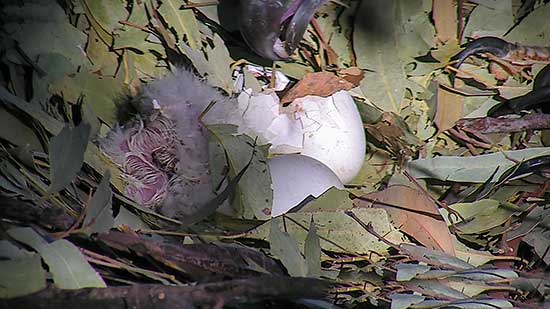
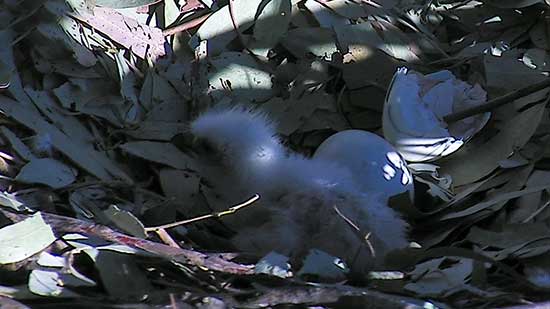
The first chick SE-19 hatched after 40 days incubation around 12:45AM on 23 July 2017 after pipping the previous day. Hatching took just over 30 hours, a long process.
After a couple of days, strange behaviour was observed at the nest. The chick was unattended most of the day, after an early feed. At dusk, loud calling was heard and interaction between eagles over and beside the nest. Two eagles, talons thrusting, fell to the ground below, apparently injured. A small team of our volunteers entered the forest in the dark, after approval, to investigate. Two adult eagles were on the ground. One eagle was captured carefully and as it was injured, was taken to the nearby Animal Referral Hospital. It was given antibiotics and was kept in care until further examination. The second eagle was left alone, as it was roosting in a tree nearby.
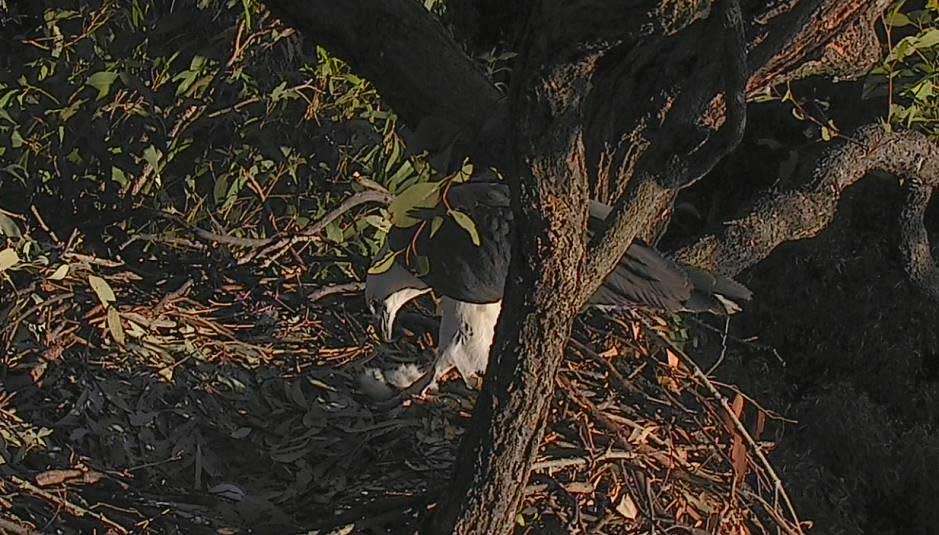
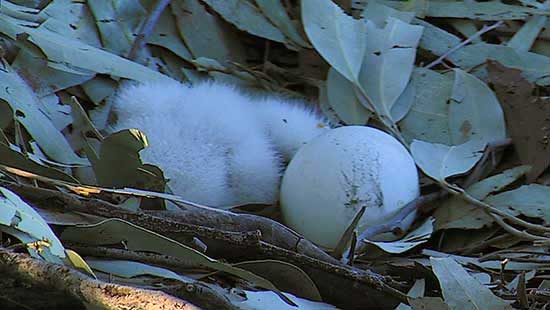
On the 4th night after hatching SE-19 died on the nest, probably from exposure, as it had not been brooded at all overnight or during the previous day. During the day, the eagles were heard calling and were seen on the nest tree, mating several times. Is this re-bonding and establishing territory after the dispute? Neither eagle however attempted to brood the chick or incubate the remaining egg.
The injured eagle at the Animal Referral Hospital had died overnight and was confirmed as a young female, an intruder in the nest territory. She was 5-6 years old, just coming into sexual maturity and in excellent condition. An autopsy was performed to determine cause of death. Samples were taken for testing for Persistent Organic Pesticides, for Beak and Feather Disease and for other possible problems. Her feathers were kept for imping, (feather transplant for injured birds ). The resident pair appeared to have fought to protect their territory, at the expense of the intruder and their own nestling and unhatched egg.
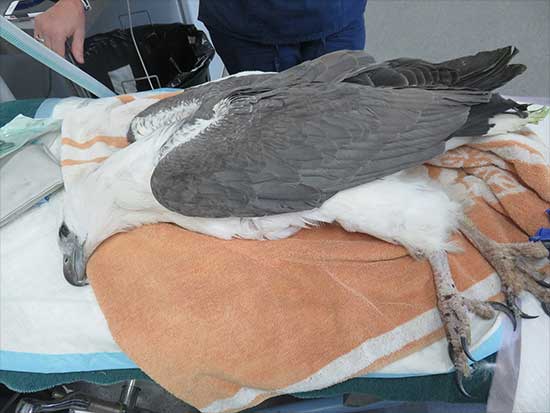
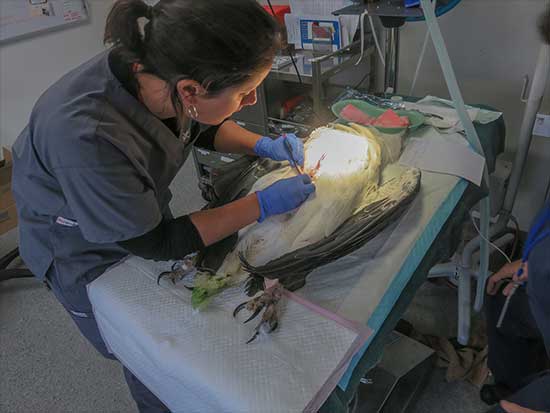
The female removed the dead body of SE-19 the chick from the nest after a few days. The body was not found. Both adults continued to incubate the unhatched egg, which as expected, showed no sign of pipping, being well beyond the expected hatch date. Interestingly, the male gradually began to spend more time incubating the egg, even at night, which has been rarely seen on this nest. The egg was uncovered all night a couple of times.
By early October, the eagles were spending little time on the nest, and were seen on their favourite river roost. Live streaming was discontinued, as the cameras and cabling were disconnected for a proposed environmental burn in the Nature Reserve forest.
As observed in the past, the main prey brought to the nest was fish, of several species. Both eagles fed the young eagle on the nest before it died.
This on-going project contributes to knowledge about and protection of this Vulnerable species. The project also satisfies activities suggested by the Office of Heritage and Environment to protect the White-bellied Sea-Eagle:
• Protect known populations and areas of potential habitat from clearing, fragmentation or disturbance.
• Establish 'buffer zones' around nest sites to limit disturbance by humans or human activity. Where nests are located in extensive undisturbed bushland a minimum buffer distance of 500m should be maintained. Where nests are located closer to existing developments a minimum buffer distance of 250m should be maintained, along with an undisturbed corridor at least 100m wide extending from the nest to the nearest foraging grounds.
• Conduct annual, broad surveys to monitor known nest sites, locate new nest sites, determine breeding success and trends in populations, and determine areas of critical habitat.
• Educate the public about the Sea-Eagle and its status, promote the conservation of the species, and encourage members of the public to report sightings of Sea-Eagles to the appropriate authorities.
(http://www.environment.nsw.gov.au/threatenedspeciesapp/profile.aspx?id=20322)

